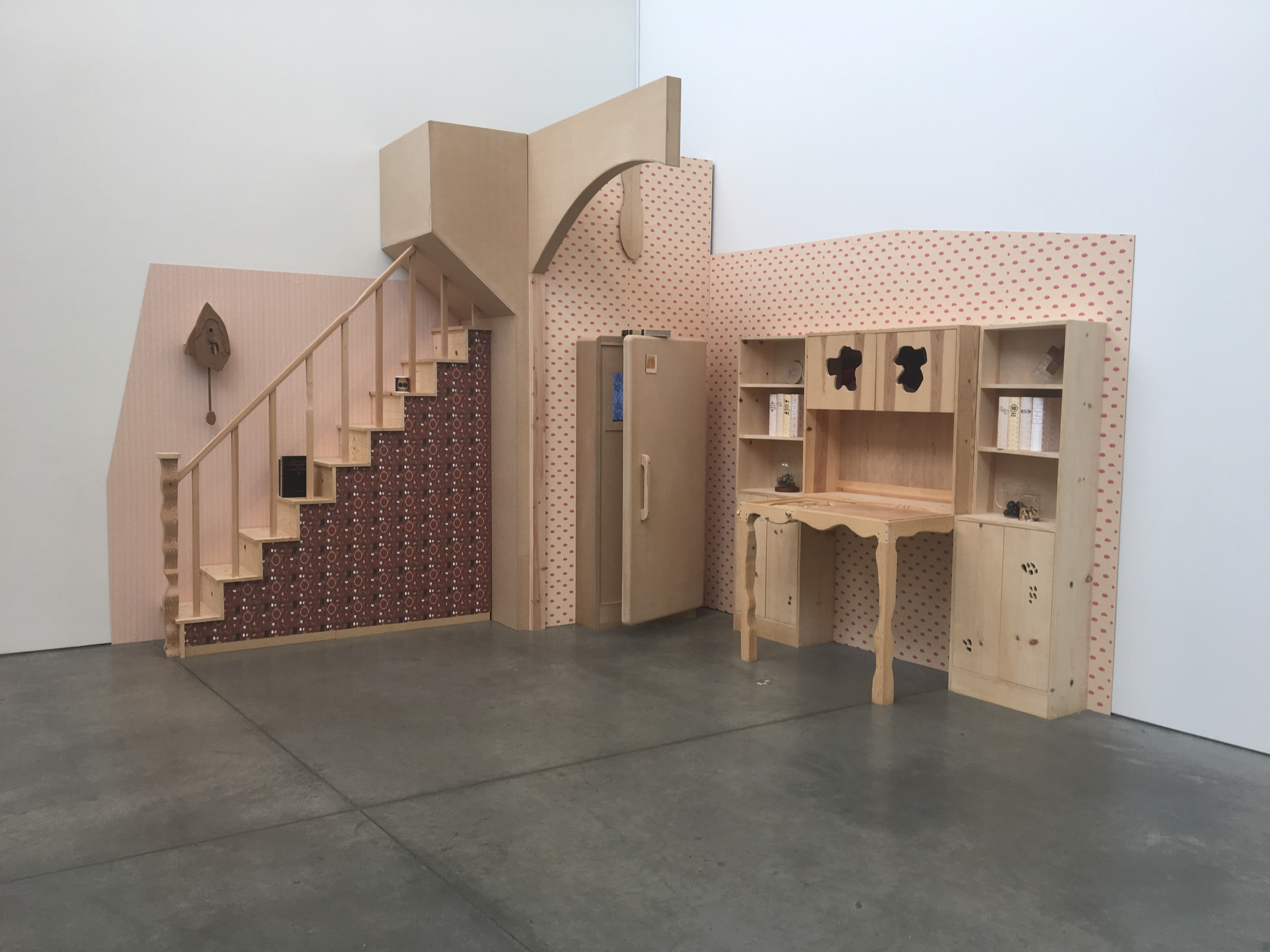Every spring, the six second-year MFA students show their final works in the newly opened Berkeley Art Museum and Pacific Film Archive. This year, the works are deeply autobiographical.
Immediately upon entering the gallery, an overwhelming sense takes over the viewer. Each piece, except for one, is larger than life size, if not an immersive installation. The sound from Shari Paladino’s installation, Habitas, draws the viewer in first. A staircase leading to nowhere, a non-functioning cuckoo clock, a fridge left ajar, and a kitchen table with shelving took up one whole corner of the room. All of this is cut and carved out of wood, with intentional irregularities sprinkled throughout. Outdated wallpaper lines the walls to make the viewer feel as though they are standing in someone’s kitchen, perhaps the artist’s. Partially hiding inside the wooden fridge is a video monitor, playing intimate dialogues between family members.
To the right is Jovi Schnell’s triptych of very large and brightly painted canvases. Schnell identifies as a painter of “kaleidoscopic systems” – where large swaths of vivid, blending colors are cut off by white, blank, negative spaces – just like what children see when they search for new forms through the kaleidoscope. Lucas DeGuilo’s three “untitled” pieces, directly across the room from Schnell’s work, are large pieces of plywood, which are carved, painted, and inked to create the swirling, calligraphic effect traditionally used by ancient Chinese painters. The nature walks he takes his students on in Sausalito inspire his work. The diametric opposition of DeGuillo’s natural materials and dark tones contrasts well with Schnell’s lively forms and vibrant color palette.
Three ceramic forms displayed on pedestals, by Takming Chuang, take up the back left corner of the gallery. Upon closer inspection, however, it becomes apparent that these shapes are sinking into their pedestals. Chuang left his pieces unfired and wrapped the clay in plastic to give them a flesh-like appearance, as this is the quality he usually invokes in his work. His sculptures are rolled up like linens, splayed out like meat in the butcher's window, and the signs above forbid you from doing what you really want to do – touch.
Andrew Wilson’s installation is in the middle of the room. A wooden chair sits atop a low pedestal covered in what looks like stars. As you get a little bit closer, you realize what they really are – bronze casted cotton boll husks. And what about the cushion of the simple wooden chair? Hair and cotton are trapped beneath the shiny plastic seat cover. In the program catalog, Wilson talks about how his work revolves around how black male bodies are consumed and commodified throughout the history of the United States.
At the opposite end of the room, hangs and lies Behnaz Khaleghi’s installation. Colorful fabrics and yarn droop and float in the corner opposite from Paladino’s. Furry shades of brown and pink invoke feminine qualities, enveloped by a figure that Khaleghi refers to as the “castrating woman”, whose arms reach across both walls. The piece is called In Heaven, which is a representation of the Middle Eastern artist’s wish of a feminist’s version of heaven, one in which women are in power and men are the anxious ones.
This show stands out for being a deeply personal one. Whether their works reference their family history, their bodies, or their experiences, the artist’s memories and feelings are palpable. Though six pieces may not feel like much, any viewer of this show can relate to these artist’s responses to social constructs and personal histories.
This show closes soon – June 11th. Be sure to catch it before it’s over! Photographs cannot capture what it is like to be in this gallery space. BAMPFA is offering reduced admission ($5) until June 11th, so now is an excellent time to see what Berkeley’s MFA graduates have been working on.
